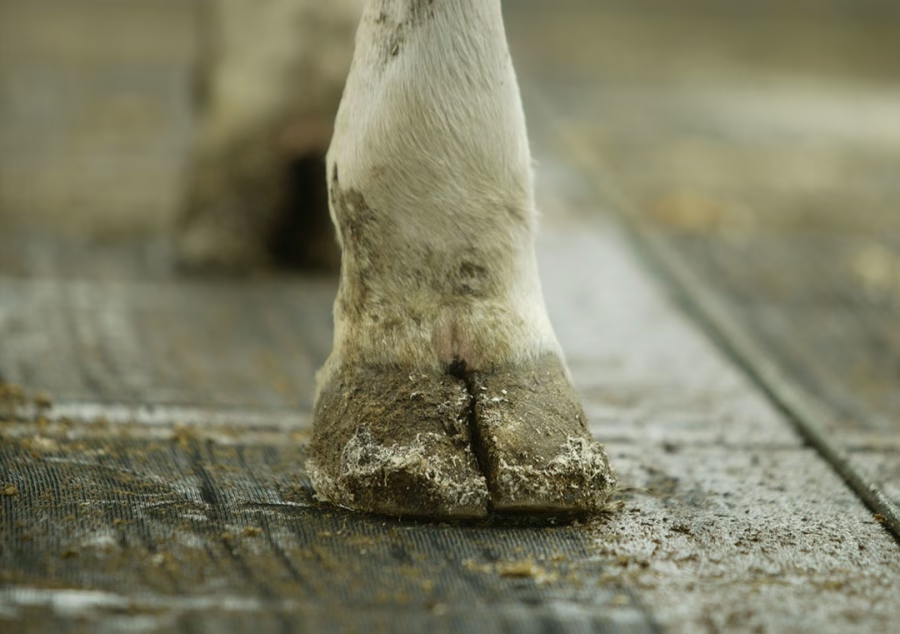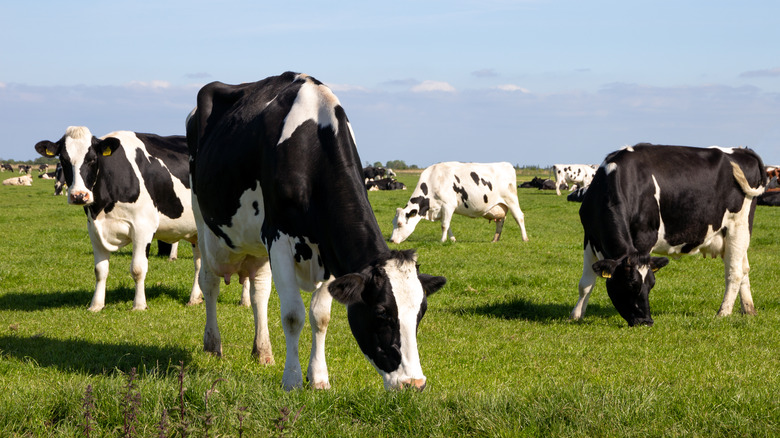Unlock the secret to healthier cows and higher profits! Discover how controlled vs. high-energy diets for transition cows can revolutionize your herd’s health and productivity. From reducing metabolic disorders to boosting milk production, learn top dairy farmers’ game-changing strategies. Don’t miss out!
Let’s address a subject that’s been generating considerable discourse in the barn lately: the debate between controlled and higher-energy diets for our transition cows. It’s understandable if you’re apprehensive about navigating another intricate feeding regimen. However, staying with me on this could revolutionize your herd’s health and significantly impact your farm’s financial outcomes.
Picture this: It’s the middle of the night, 3 AM, and you find yourself in the barn, keeping a vigilant watch over your newly freshened cows. This scenario is familiar to many. You’re wishing for everything to progress without a hitch. Yet, there’s an underlying concern lingering in your thoughts — the looming threat of ketosis, the unsettling possibility of a displaced abomasum, and the myriad other challenges that accompany the transition period. But what if the secret to facilitating easier calvings and nurturing healthier fresh cows lay within the dietary regimen of our dry cows?
Indeed, this is precisely the case. We’ll explore controlled versus higher-energy diets tailored for transition cows, unearthing how these varied feeding strategies influence factors like liver inflammation, rumen integrity, and postpartum condition. Rest assured, even amidst the complexity, our discussion will remain as straightforward as possible.
The Nitty-Gritty: Key Points to Chew On
1. The Transition Period: A Cow’s Rollercoaster Ride
We begin with the fundamentals, observing the transition period, which covers the critical span of approximately three weeks preceding calving and extends into the following three weeks. This phase represents a tumultuous time for dairy cows, akin to the transformative upheaval experienced during adolescence. Within this timeframe, cows diligently nurture their unborn calves, brace themselves for the formidable demands of calving, and simultaneously prime their systems for the impending needs of milk production. Such drastic physiological transformations make them susceptible to a spectrum of metabolic challenges.
2. Controlled Energy Diets: The “Goldilocks” Approach
Turning to controlled energy diets, imagine these as the “Goldilocks” solution—balanced to perfection, ensuring neither excess nor deficiency. Here, the intent is to supply cows with the required energy, eliminating any surplus or shortfall.
How it works:
- We typically use high-fiber, low-energy ingredients like straw to “dilute” the energy density of the diet.
- The goal is to prevent cows from overeating and gaining too much condition before calving.
- It’s like putting your cows on a sensible diet rather than letting them hit the all-you-can-eat buffet.
Benefits:
- Lower risk of fatty liver disease
- Improved insulin sensitivity
- Better dry matter intake after calving
- Potentially fewer metabolic disorders
Recent research in New Zealand has provided specific recommendations for metabolisable energy (ME) intake in the two weeks before calving, based on the cow’s body condition score (BCS) and weight:
| Mid-Lactation LWT | Pre-Calving LWT | BCS < 5.0 | BCS ≥ 5.0 |
|---|---|---|---|
| 400 kg | 500 kg | 95 MJ ME/d | 80 MJ ME/d |
| 450 kg | 560 kg | 103 MJ ME/d | 87 MJ ME/d |
| 500 kg | 625 kg | 111 MJ ME/d | 94 MJ ME/d |
| 550 kg | 690 kg | 119 MJ ME/d | 101 MJ ME/d |
This table illustrates that cows with a BCS of 5 or more significantly benefit from slightly restricted energy intake (about 85% of requirements). In contrast, cows with a BCS below five should be fed to meet their complete energy requirements. This approach helps manage the risk of metabolic disorders while ensuring adequate nutrition for all cows.
Further research has shown that controlled energy diets can be effectively formulated using a combination of forages and concentrates. Here’s an example of the composition of two controlled energy diets used in a study comparing different forage levels:
| Ingredient (% of DM) | 77% Forage Diet | 87% Forage Diet |
|---|---|---|
| Grass Silage | 39.8 | 44.8 |
| Alfalfa Hay | 19.9 | 22.4 |
| Wheat Straw | 17.3 | 19.5 |
| Concentrate Mix | 23.0 | 13.3 |
This table illustrates how controlled energy diets can be formulated with different forage-to-concentrate ratios while maintaining a relatively low energy density. The 87% forage diet represents a more aggressive approach to managing energy intake, while the 77% forage diet allows for slightly more concentrated inclusion.
3. Higher Energy Diets: The Traditional Approach
Conversely, we encounter the higher energy diets, a method steeped in tradition. Many recall being taught that increasing dietary energy before calving was crucial. This “steaming up” of cows aimed to prepare them for the lactation demands.
How it works:
- These diets are more energy-dense, often with higher grain or corn silage levels.
- The theory is that this prepares the rumen for the coming high-energy lactation diets.
Potential benefits:
- May help cows maintain body condition if they’re under-conditioned
- Could support higher milk production in early lactation
4. Liver Inflammation: The Silent Troublemaker
Let us delve into a topic that often lurks in the shadows yet harbors the potential for significant impact: liver inflammation. Like a covert adversary in your cornfield, its presence is not always immediately apparent, yet its influence can be profoundly disruptive.
Controlled energy diets:
- tends to result in less liver inflammation
- Why? Because cows are less likely to mobilize excessive body fat
Higher energy diets:
- May increase the risk of liver inflammation, especially if cows overeat
- This inflammation can interfere with the liver’s ability to process nutrients effectively
5. Rumen Health: Happy Rumen, Happy Cow
A healthy rumen is like a well-oiled machine – it keeps everything running smoothly. Let’s see how our two dietary approaches stack up:
Controlled energy diets:
- Often include more forage, which is excellent for rumen health
- Higher fiber content promotes chewing and saliva production, naturally buffering the rumen
Higher energy diets:
- May lead to more rapid fermentation and lower rumen pH
- This could increase the risk of subacute ruminal acidosis (SARA) after calving
6. Post-Partum Performance: The Proof is in the Milk Pail
We’re all interested in how these diets affect our cows’ performance after calving. Here’s the scoop:
Controlled energy diets:
- Often results in better dry matter intake after calving
- May lead to lower peak milk but better persistency
- Typically associated with fewer metabolic disorders
Higher energy diets:
- Might support higher peak milk production
- But could also increase the risk of metabolic issues, potentially offsetting production gains
Recent research has shed light on how different feeding strategies affect markers of inflammation in transition cows. One such marker is haptoglobin (HP), an acute phase protein that increases during inflammation. A study of 72 farms found interesting differences in HP levels based on feeding strategies:
| Feeding Strategy | Prevalence of Elevated HP (%) |
|---|---|
| Controlled energy (far-off) | 47.7 ± 2.8 |
| Not controlled energy (far-off) | 49.0 ± 3.4 |
| High forage NDF (close-up) | 51.6 ± 3.6 |
| Low forage NDF (close-up) | 45.0 ± 2.7 |
| Low starch (fresh) | 47.2 ± 5.0 |
| High starch (fresh) | 59.9 ± 4.6 |
This data suggests that while controlled energy diets in the far-off period didn’t significantly affect HP levels, lower forage NDF diets in the close-up period and lower starch diets in the fresh period were associated with lower inflammation marker levels.
7. One Size Doesn’t Fit All: Tailoring Your Approach
The crucial factor is that what proves successful on one farm may not necessarily yield the same results on another. Selecting an approach is akin to choosing a tractor; evaluating your distinct requirements and circumstances is imperative.
Factors to consider:
- Your herd’s genetics
- Your management style
- Available feed resources
- Housing facilities
Practical Applications: Bringing It Home to Your Farm
How do we take all this fancy science talk and put it to work in our barns? Here are some practical tips:
- Know your herd: Record body condition scores, metabolic disorders, and milk production to gauge whether your current approach is practical.
- Analyze your feeds: Regular feed testing is crucial. You can’t formulate a controlled energy diet if you don’t know what you’re working with.
- Work with your nutritionist: They can help you formulate diets that meet your cows’ needs without overfeeding energy.
- Monitor dry matter intake: It’s key to monitor intake, whether you’re using controlled or higher-energy diets.
- Consider using a two-group dry cow system: This allows you to tailor diets more precisely to cows’ changing needs as they approach calving.
- Pay attention to particle size, especially if using straw in controlled energy diets. Cows are clever – they’ll sort out the good stuff if you let them!
- Don’t forget about minerals and vitamins: Regardless of energy level, ensure your transition diets are appropriately balanced for all nutrients.
Busting Myths: Separating Fact from Fiction
Let’s clear up some common misconceptions about transition cow feeding:
Myth 1: “Steaming up” cows is always necessary. Reality: Many cows do just fine, or even better, on controlled energy diets. It’s not one-size-fits-all.
Myth 2: Controlled energy diets will tank my milk production. Reality: While peak milk might be slightly lower, overall lactation yield and cow health often improve.
Myth 3: Adding straw to the diet is just filler. Reality: When used correctly, straw is a valuable tool for controlling energy intake and promoting rumen health.
Myth 4: Higher energy diets are always bad. Reality: They can be appropriate in some situations, like for under-conditioned cows or in specific management systems.
Myth 5: Controlled energy diets are too complicated to implement. Reality: With proper guidance and management, many farms successfully use this approach.
The Bottom Line
Where do we proceed from this point? The evidence is unequivocal – for numerous herds, controlled energy diets deliver substantial advantages in enhancing transition cow health and overall productivity. However, bear in mind, it’s not a panacea. Achieving success hinges on meticulous execution and management.
Here are some next steps to consider:
- Evaluate your current transition cow program. Are you seeing the results you want?
- Talk to your veterinarian and nutritionist about the potential benefits of controlled energy diets for your herd.
- If you decide to make changes, do so gradually and monitor your cows closely.
- Keep learning! Attend workshops, read articles, and stay up-to-date on the latest research in transition cow nutrition.
Ultimately, a smooth transition is crucial for maximizing lactation yields. Diligently strategizing our dry cow nutrition plans will ensure the prosperity of our cows and enrich our agricultural viability.
How about you? Are you prepared to fine-tune your cows’ energy management? We invite you to engage by sharing your insights and experiences in the comments. Our collective wisdom is invaluable, bringing us closer to our goals.
Key Takeaways:
- Controlled energy diets align with the “Goldilocks” approach, offering a balanced energy intake that meets cow nutritional needs without overfeeding.
- High-energy diets, while traditional, can increase risks of liver inflammation and metabolic disorders if not carefully managed.
- Liver inflammation remains an understated issue, potentially disrupting nutrient processing if cows overeat with high-energy diets.
- Healthy rumen function is critical; controlled diets with high-fiber forage support optimal rumen health.
- Post-partum performance varies, with controlled diets enhancing long-term milk production sustainability, while high-energy diets might boost early peak production.
- A tailored approach to diet formulation considers herd genetics, management style, and available resources to ensure optimal outcomes.
- Understanding your herd’s needs through monitoring and collaboration with a nutritionist can optimize feeding strategies.
Summary:
Managing transition cows in dairy herds is vital for their health and productivity, focusing on choosing between controlled and high-energy diets. These feeding strategies affect how well cows avoid metabolic disorders, keep their rumens healthy, and perform after calving. Controlled energy diets, with high-fiber options like straw, aim to prevent overfeeding and reduce health issues. On the other hand, higher-energy diets prepare cows for milk production but can pose risks. The choice of strategy depends on each farm’s specific needs and resources. Understanding and applying the proper diet can lead to healthier cows, better milk production, and successful dairy farming.
 Join the Revolution!
Join the Revolution!
Bullvine Daily is your essential e-zine for staying ahead in the dairy industry. With over 30,000 subscribers, we bring you the week’s top news, helping you manage tasks efficiently. Stay informed about milk production, tech adoption, and more, so you can concentrate on your dairy operations.







 Join the Revolution!
Join the Revolution!





